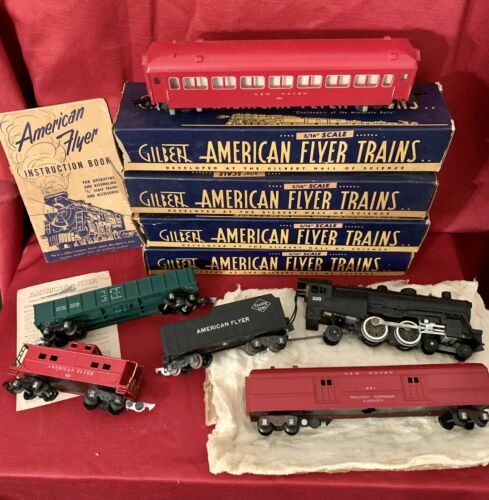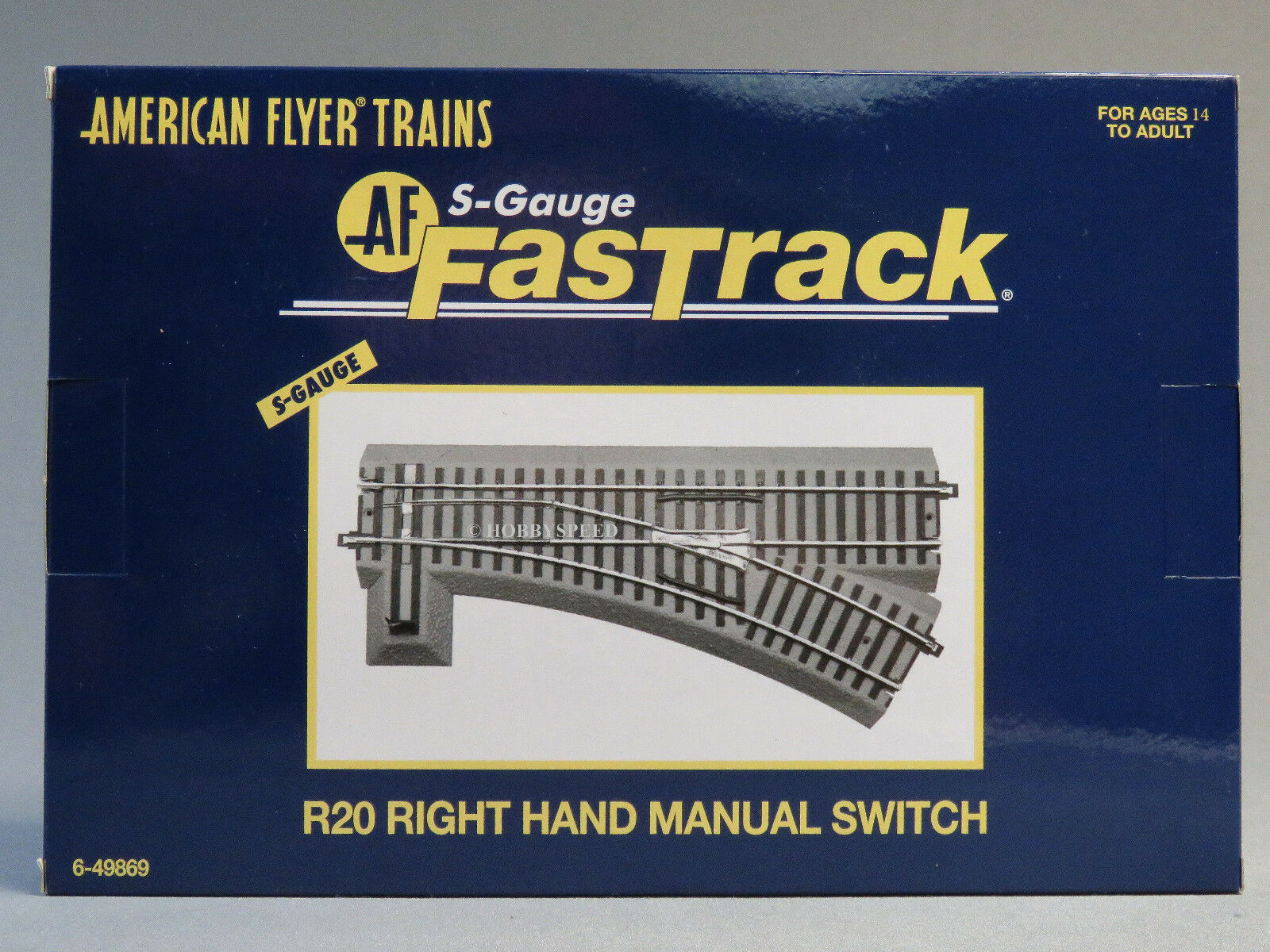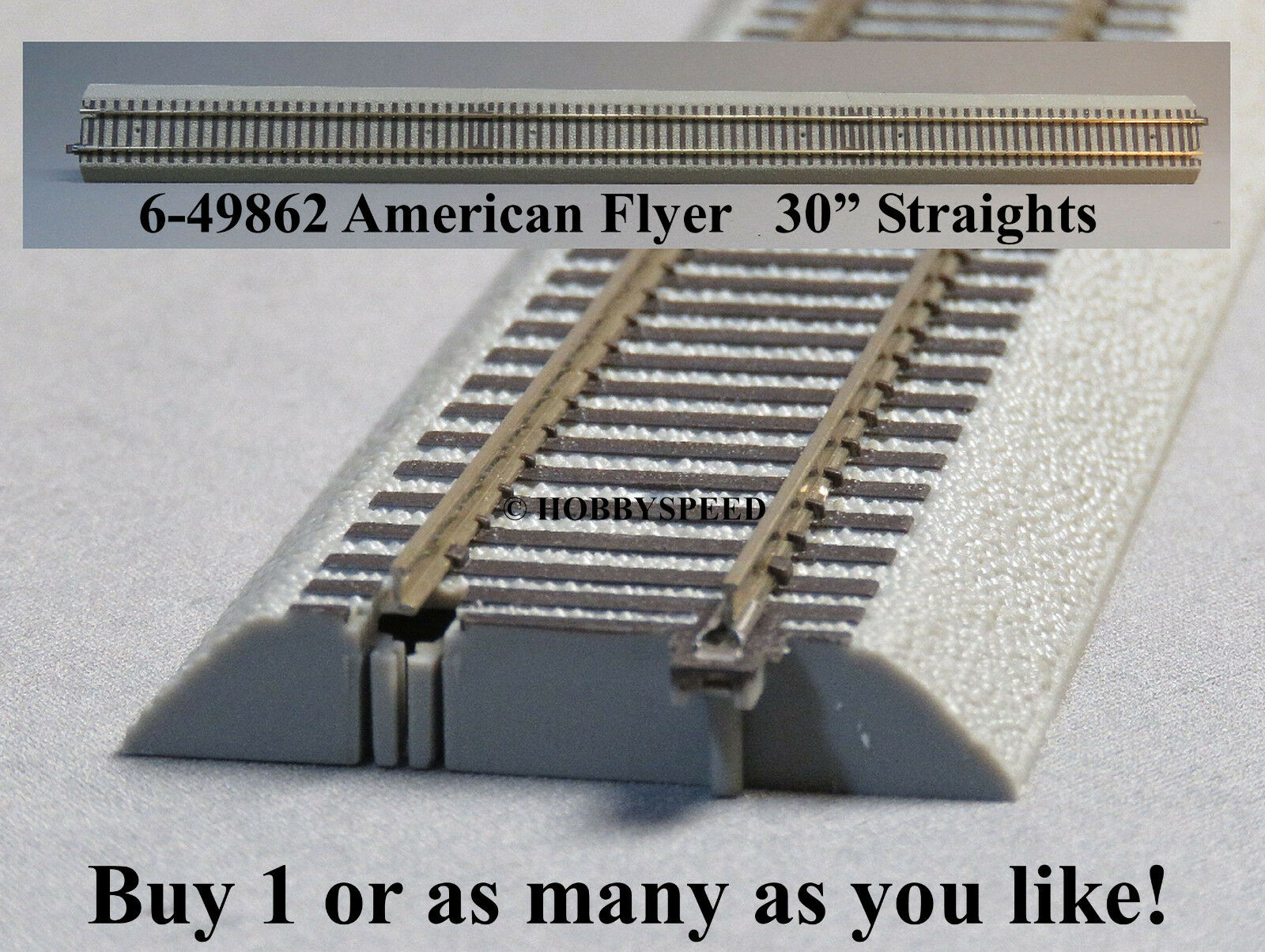-40%
American Flyer Train SET - 300 Reading Line - Vintage S Gauge Post-War
$ 185.32
- Description
- Size Guide
Description
American Flyer Trains 300 Reading LineVintage - Gift For Collectors
Condition is "Used"
As requested by an eBay shopper we hooked up a 36 in circle of track. Connected the transformer and put down the tender and engine - the headlight lit but it did not initially move.
We freed up the electric engine brushes and wheels and did a cursory buffing of the track surface - We did not lubricate the engine, gears or wheels
The Locomotive after that successfully made two slow passes around the circle
It functions well, however it will take someone with a little TLC to clean the tracks and lubricate the engine to bring it up to speed
This engine has been out of use for more than 2 Years - As per the included instructions, the engine needs to be properly cleaned, lubricated & oiled before operating
Shipped with USPS Retail Ground
With this grouping of American Flyer Trains we have:
• (3) three passenger cars with the original box
• (1) railway express agency car 651 New Haven line which is the mail car
• (1) Locomotive number 300 Reading Lines & Coal Tender - Headlight confirmed to light
• American Flyer 638 red caboose
• TNP Texas and Pacific 631 Coal tender
• Original American Flyer instruction book for operating and assembling 3/16 scale Trains and Accessories from the AC Gilbert Company, Erector Square, New Haven, the Gilbert Hall of Science
• (1) one of the intact passenger cars confirms to light up New Haven line number 650 bright red
• (2) Electrified Crossing Switch tracks
• Instruction manual operating instructions for the worm drive locomotive sheet
• (9) 10 inch sections we have nine of them so you get 90 inches of straight track
• (12) curve sections forming a 36 inch Circle or 113 inches circumference
Internet Research
Vintage American Flyer Model Railroad Trains
https://www.collectorsweekly.com/model-trains/american-flyer
American Flyer toy trains first chugged onto the scene around 1907 as windup, tin plate O Gauge trains, a cheaper alternative to the larger-scale electric trains made by Lionel and others. The firm that produced them, founded by William Ogden Coleman in Chicago, was originally called Edmonds-Metzel Manufacturing Company, and Ogden was briefly joined in it by William Hafner, who went on to launch his own Hafner line of windup trains in 1914.
Before the company changed its name to American Flyer Manufacturing Company in 1910, it only produced passenger-train sets, known as “Chicago cars,” as they weren’t numbered but had “Chicago” stamped onto their sides. Then, in 1910, the newly minted American Flyer company launched its first line of freight cars. The company also produced a lower-end Hummer line of passenger and freight cars, though these were never branded with the American Flyer name.
Finally, in 1918, with the market already dominated by Lionel and Ives, American Flyer began producing electric locomotives and cast-iron O Gauge trains, using technology that had been developed 20 years earlier. Between 1920 and 1934, the company released electric toy trains meant to resemble trains running in New England at the time. They were made out of lithographed steel, enameled steel, and cast iron.
To compete with Ives, Lionel, and Dorfan, American Flyer launched a larger, “premium” line of electric toy trains in 1925. These trains could run on Lionel’s “Standard Gauge” tracks, which American Flyer named “Wide Gauge” (both were 2 1/8 inches between the rails). Marketed as “Wonder Trains,” American Flyer’s shiny, brightly colored train sets had patriotic names like “American Legion,” “President’s Special,” and “Mayflower.”
They were also extremely pricey for the 1920s. The cadmium-plated “Mayflower” set, for example, ran about 0, a full month’s salary for an average person. In 1926, the company joined up with Lionel to produce hybrid freight cars for a line featuring Lionel bodies on American Flyer trucks.
Around 1929, American Flyer joined forces with Lionel again to buy out Ives, and for a few years, all three brands were produced by the same conglomeration, featuring a mix-and-match of each company’s parts. Then, in 1931, Lionel bought out American Flyer’s share of Ives, and American Flyer was on its own again.
These efforts were not met with much success. American Flyer was hit hard by the Great Depression that started in 1929—by 1932, it had stopped manufacturing its Wide-Gauge line entirely, and it sold off its stores through 1936. Instead, it focused mostly on low-end O-Gauge toys, with the exception of its high-quality diecast New York Central Hudson, produced in 1936. Toward the end of the decade, Coleman was struggling with a failing company and failing health.
Fortunately, entrepreneur Alfred Carleton (A.C.) Gilbert, inventor of Erector toys, was looking for a way to break into the toy train market. In 1938, he eagerly bought out the company. A Yale medical school graduate and record-breaking Olympic pole-vaulter, the vigorous and aggressive Gilbert had just what the company needed—high standards and the business smarts to pull the company out of debt. Coleman worked out a potentially lucrative royalty deal with Gilbert, but he died in 1939 before he could reap the benefits. After Coleman’s death, Gilbert closed American Flyer’s Chicago plant and moved all of its manufacturing to New Haven, Connecticut.
Right before World War II, Gilbert revived the company by tapping into the emerging adult-hobbyist market, launching its own 3/16-inch scale (1:64) trains, which were about two-thirds the size of O-Gauge trains but ran on a three-rail O-Gauge track. Focusing on realism, Amercian Flyer put out this line of tiny, high-quality, and highly detailed diecast train sets in 1939, led by the acclaimed Union Pacific 4-8-4 “Challenger” Model 806.
Model train hobbyists were even more taken with 1940’s diecast Pennsylvania K-5 locomotive and the Baltimore & Ohio “Royal Blue” 4-6-2. American Flyer also produced inexpensive sheet-metal versions for consumers who didn’t have such deep pockets—Gilbert gave the O-Gauge line a sprucing up in 1941 with updated features and a new coat of paint. However, the arrival of World War II meant the company had to devote 95 percent of its production and materials to the war effort, making pieces for machine guns and landmines.
In anticipation of America’s involvement in the war, Gilbert opened the Gilbert Hall of Science in New York on September 17, 1941, to keep his company’s name in the public consciousness. It was a brilliant marketing maneuver, showcasing American Flyer products, as well as Erector sets and other Gilbert items like chemistry sets and microscopes. Soon, other cities had their own smaller versions of Gilbert Hall.
After the war, Gilbert was caught off guard by how quickly Lionel introduced its new train featuring a life-like knuckle coupler (the mechanism for connecting train cars). In 1946, Gilbert struck back with its even more realistic S-Gauge track, a two-rail line for its 3/16-scale American Flyer trains. Still, Gilbert could not knock off the patented Lionel coupler, which meant its customers were left with its disappointingly simple link coupler.
Still, the S-Gauge line had a devoted following of fans, who were drawn to the detail and realism of the trains. Lionel trains, however, had more bells and whistles—literally. Lionel’s patented built-in whistle sounded just like a real steam engine’s—American Flyer fans had to content themselves with “whistling billboards” off to the side of the track, or the wheezy, fake sound of the “Nathan air-chime” whistle.
Like Lionel, Gilbert sent vast American Flyer train layouts and sets to department stores for their Christmas displays. In the 1950s, his company even made special displays for television shows like Dave Garroway’s “Today” show, “The Price is Right,” and “American Bandstand.”
When Gilbert died in 1961, his son, Alfred Jr., took over the company, only to sell 52 percent of it to “Lassie” producer Jack Wrather. By 1966, American Flyer was sold to Lionel, which continued to produce popular American Flyer pieces like the Alco PA and the Electro-Motive GP7.
From a Lionel Train Site
Lionel S-Gauge sets and locomotives are approximately 1:64 scale and are sold under the name American Flyer®. Lionel S-Gauge track (AF FasTrack®) is narrower than O, has two rails and supports American Flyer and other S-Gauge cars. Lionel recommends S-Gauge for train hobbyist and collectors who prefer a scale smaller than our Traditional O-Gauge or O Scale line.
Traditional S-Gauge
Based on classic American Flyer® designs
Approximate scale proportions
Easy to control lights, sounds, and smoke
Very accessible products to customers
Ready-to-Run sets are Traditional S-Gauge, and contain everything a customer needs to run their train in minutes – train set, oval of track, and, power supply.
Lionel launched a new remote system for engines in 2015 under the FlyerChief™ umbrella. These are new sets with enhanced sound, long distance controls, AC/DC Compatible and are easy to set-up and operate
To allow customers to continue to add product, Lionel sells specialty track products, rolling stock.
S Scale:
Higher-end products
Larger than Traditional S-Gauge products since they are more true to 1:64 scale proportions
Contains more detail with separately applied parts
Engines have sophisticated electronics such as the Lionel LEGACY™ Control System , Lionel RailSounds® , and Digital Command Control (DCC)
Geared towards collectors and sophisticated hobbyists
Optional Kadee coupler mounting pads
#TrainSET #AmericanFlyer #300ReadingLine #Vintage #SGauge #PostWar #Train #AmericanFlyer300 #ReadingLine #PostWarTrainSET
#R
ailwayExpressAgencyCar #651 #NewHavenLine #MailCar #
Locomotive #300 #ReadingLines #
AmericanFlyer #638 #Caboose #
TNP #TexasAndPacific #631 #CoalTender #
OriginalAmericanFlyerb #ACGilbertCompany #ErectorSet #GilbertHallOfScience
#
ElectrifiedCrossingSwitch #Tracks #
InstructionManual #WormDriveLocomotive #Collection #Collectable #ManCave #Trains #VintageTrains #VintageTrainSet #CollectableTrains #ChristmasTrain #ChristmasGift #Collector



















